Mineralogy and Critical Metal Distribution in Upper Carboniferous Aluminum-Bearing Strata from the Yangquan Mining Area, Northeastern Qinshui Basin: Insights from TIMA
Abstract
1. Introduction
2. Geology Setting
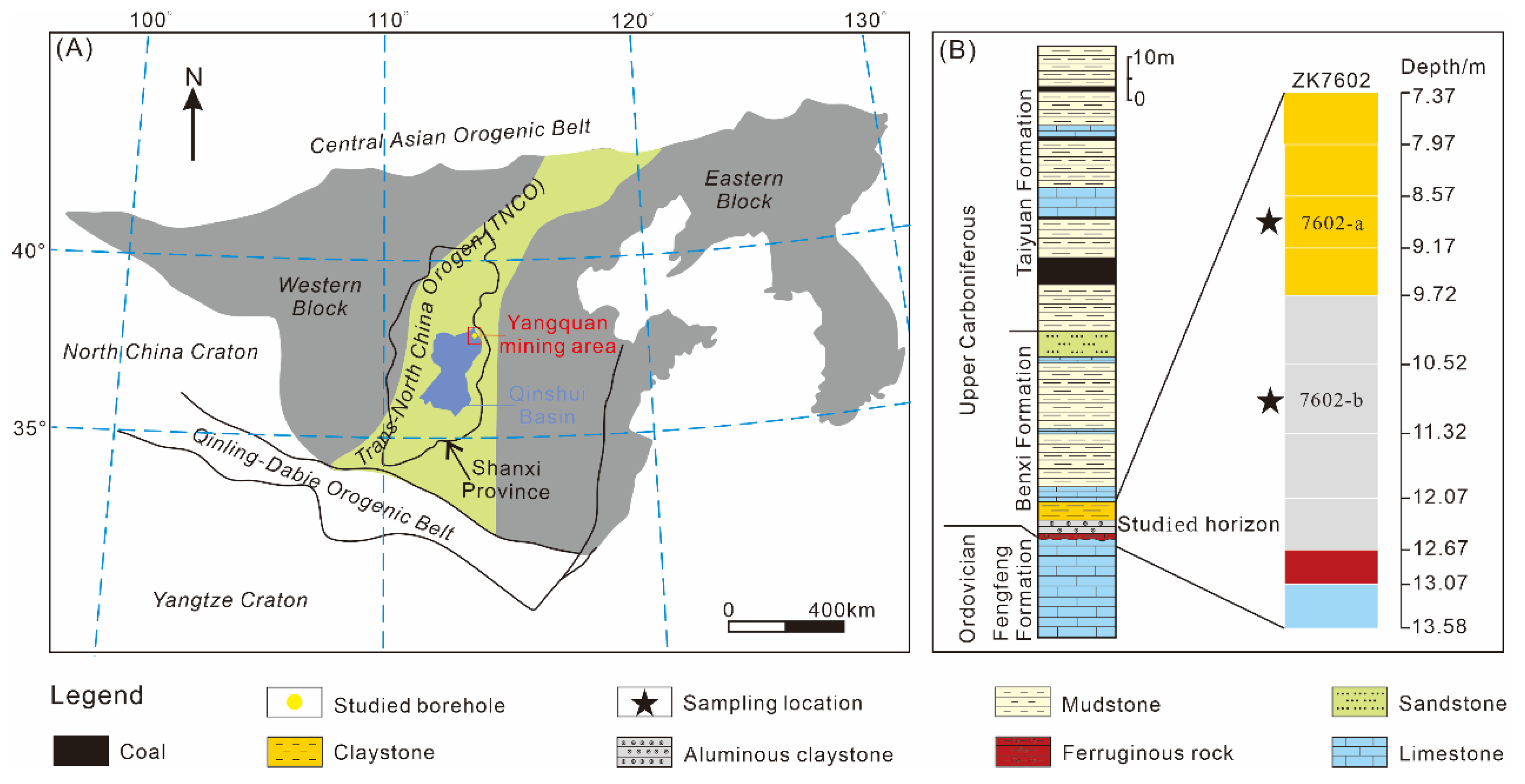
3. Samples and Analytical Methods
3.1. Sample Collection
3.2. Analytical Methods
3.2.1. XRD
3.2.2. TIMA
3.2.3. Clay Separation Experiment
4. Results
4.1. Mineralogical Phases Identified by XRD and TIMA
4.2. XRD of Oriented Specimens
5. Discussion
5.1. Modes of Occurrence of Ti
5.2. Modes of Occurrence of Li
5.3. Modes of Occurrence of Ga and Zr
5.4. Modes of Occurrence of REEs
6. Conclusions
Author Contributions
Funding
Data Availability Statement
Acknowledgments
Conflicts of Interest
References
- Müller, D.; Groves, D.I.; Santosh, M.; Yang, C.-X. Critical metals: Their applications with emphasis on the clean energy transition. Geosyst. Geoenviron. 2024, 4, 100310. [Google Scholar] [CrossRef]
- Grandell, L.; Lehtilä, A.; Kivinen, M.; Koljonen, T.; Kihlman, S.; Lauri, L.S. Role of critical metals in the future markets of clean energy technologies. Renew. Energy 2016, 95, 53–62. [Google Scholar] [CrossRef]
- Moss, R.; Tzimas, E.; Kara, H.; Willis, P.; Kooroshy, J. Critical Metals in Strategic Energy Technologies; Publications Office of the European Union: Luxembourg, 2011. [Google Scholar]
- Moss, R.L.; Tzimas, E.; Kara, H.; Willis, P.; Kooroshy, J. The potential risks from metals bottlenecks to the deployment of Strategic Energy Technologies. Energy Policy 2013, 55, 556–564. [Google Scholar] [CrossRef]
- Han, S.; Zhenghao, M.; Meilin, L.; Xiaohui, Y.; Xiaoxue, W. Global supply sustainability assessment of critical metals for clean energy technology. Resour. Policy 2023, 85, 103994. [Google Scholar] [CrossRef]
- Mongelli, G.; Boni, M.; Oggiano, G.; Mameli, P.; Sinisi, R.; Buccione, R.; Mondillo, N. Critical metals distribution in Tethyan karst bauxite: The cretaceous Italian ores. Ore Geol. Rev. 2017, 86, 526–536. [Google Scholar] [CrossRef]
- Dai, S.; Finkelman, R.B. Coal as a promising source of critical elements: Progress and future prospects. Int. J. Coal Geol. 2018, 186, 155–164. [Google Scholar] [CrossRef]
- Dai, S.; Zhao, L.; Wang, N.; Wei, Q.; Liu, J. Advance and prospect of researches on the mineralization of critical elements in coal-bearing sequences. Bull. Mineral. Petrol. Geochem. 2024, 43, 49–63. (In Chinese) [Google Scholar] [CrossRef]
- Zhang, Q.; Jiang, S.; Wang, W.; Ge, W. Current status and prospect of researches on sediment-hosted Li deposits in bauxite formations and coal-bearing strata in China. Bull. Mineral. Petrol. Geochem. 2024, 43, 90–101. [Google Scholar] [CrossRef]
- Zhang, J.; Wang, Q.; Liu, X.; Zhou, G.; Xu, H.; Zhu, Y. Provenance and ore-forming process of Permian lithium-rich bauxite in central Yunnan, SW China. Ore Geol. Rev. 2022, 145, 104862. [Google Scholar] [CrossRef]
- Ling, K.; Wen, H.; Han, T.; Lu, Z.; Cui, Y.; Luo, C.; Yu, W. Lithium-rich claystone in Pingguo area, Guangxi, southwest China: Precursor kaolinite controls lithium enrichment. Mineral. Depos. 2024, 59, 329–340. [Google Scholar] [CrossRef]
- Deng, W.; Wen, H.-J.; Du, S.-J.; Ling, K.-Y.; Fan, H.-F.; Zhu, C.-W.; Luo, C.-G.; Yang, Y. Provenance of Late Permian Nb-Zr-REE-Ga enrichment in western Guizhou: Implications for the waning volcanism of Emeishan large igneous province. Ore Geol. Rev. 2022, 150, 105160. [Google Scholar] [CrossRef]
- Sofis, N.; Ntouros, E.P.; Kalaitzidis, S. REE Mineralogy and Geochemistry of the Lower Karstic Bauxite Strata (b1), in the Parnassos-Ghiona Unit, Greece. Minerals 2025, 15, 804. [Google Scholar] [CrossRef]
- Khosravi, M.; Yu, W.; Abedini, A.; Zhou, J. Geochemical constraints on the Gano karst bauxite deposit, eastern Alborz Mountains, northern Iran: Implications for provenance, elemental mobility, and distribution of critical metals. J. Geochem. Explor. 2024, 262, 107468. [Google Scholar] [CrossRef]
- Abedini, A.; Calagari, A.A. Geochemical characteristics of bauxites: The Permian Shahindezh horizon, NW Iran. Neues Jahrb. Geol. Paläontologie Abhandlugen 2013, 270, 301–324. [Google Scholar] [CrossRef]
- Abedini, A.; Calagari, A.A. Geochemical characteristics of Kanigorgeh ferruginous bauxite horizon, West-Azarbaidjan province, NW Iran. Period. Mineral. 2013, 82, 1–23. [Google Scholar]
- Abedini, A.; Khosravi, M.; Mongelli, G. The middle Permian pyrophyllite-rich ferruginous bauxite, northwestern Iran, Irano–Himalayan karst belt: Constraints on elemental fractionation and provenance. J. Geochem. Explor. 2022, 233, 106905. [Google Scholar] [CrossRef]
- Abedini, A.; Mehr, M.H.; Khosravi, M.; Calagari, A.A. Geochemical characteristics of the karst-type bauxites: An example from the Kanirash deposit, NW Iran. Arab. J. Geosci. 2019, 12, 475. [Google Scholar] [CrossRef]
- Ahmadnejad, F.; Mongelli, G. Geochemistry of upper cretaceous bauxite deposits, Zagros fold thrust belt, SW Iran: Paleoenvironment and provenance constraints. Sed. Geol. 2023, 454, 106461. [Google Scholar] [CrossRef]
- Ahmadnejad, F.; Mongelli, G.; Parkalian, H.; Haghighi, H.; Sharifi, M. The Middle-Late Permian Yakshawa and Late Cretaceous Daresard bauxite deposits, western Iran: Elemental deportment, parental affinities and genesis of REY minerals. J. Asian Earth Sci. 2025, 277, 106397. [Google Scholar] [CrossRef]
- Ahmadnejad, F.; Mongelli, G.; Rafat, G.; Sharifi, M. The Middle–Late Permian to Late Cretaceous Mediterranean-Type Karst Bauxites of Western Iran: Authigenic Mineral Forming Conditions and Critical Raw Materials Potential. Minerals 2025, 15, 584. [Google Scholar] [CrossRef]
- Seredin, V.V.; Dai, S. Coal deposits as potential alternative sources for lanthanides and yttrium. Int. J. Coal Geol. 2012, 94, 67–93. [Google Scholar] [CrossRef]
- Zhao, H.; Wu, Z.; Zhang, S.; Zhou, X.; Wang, Y.; Cheng, H. Geochemical features of lithium–rich bauxite from the Benxi formation in Qinyuan County, Shanxi, China: Insights into their depositional environment and lithium enrichment. Ore Geol. Rev. 2023, 163, 105780. [Google Scholar] [CrossRef]
- Zhang, S.; Zhao, F.; Liu, D.; Zhao, L.; Zhang, X.; Lin, J.; Dong, H.; Zhao, S.; Liu, X.; Zan, M. Modes of occurrence of critical metal elements (Li, REEs and other critical elements) in low-grade bauxite from Southern Shanxi Province, China. Minerals 2022, 12, 990. [Google Scholar] [CrossRef]
- Wang, Z.; Li, Y.; Algeo, T.J.; Yu, W.; He, X. Critical metal enrichment in Upper Carboniferous karst bauxite of North China Craton. Mineral. Depos. 2024, 59, 237–254. [Google Scholar] [CrossRef]
- Wang, N.; Zhang, S.; Zhao, J.; Huang, G.; Sun, B. Distribution, occurrence and metallogenic prospects of critical metals in the Iron–Aluminum member of the Upper Paleozoic Benxi Formation, Yangquan mining area, eastern Shanxi. J. China Coal Soc. 2025, 44, 1949–1960. (In Chinese) [Google Scholar] [CrossRef]
- Wang, N.; Zhao, J.; Xu, Y.; Mu, M.; Zhang, S.; Jing, L.; Huang, G.; Liu, L.; Tian, P. Paleoenvironmental Controls and Economic Potential of Li-REY Enrichment in the Upper Carboniferous Coal-Bearing “Si–Al–Fe” Strata, Northeastern Qinshui Basin. Minerals 2025, 15, 269. [Google Scholar] [CrossRef]
- Yang, Q.Y.; Santosh, M.; Collins, A.S.; Teng, X.M. Microblock amalgamation in the North China Craton: Evidence from Neoarchaean magmatic suite in the western margin of the Jiaoliao Block. Gondwana Res. 2016, 31, 96–123. [Google Scholar] [CrossRef]
- Liu, X.; Zhao, L.; Wang, Q.; Sun, X.; Liu, L.; Yang, S.; Deng, J. Provenance and genesis of karstic bauxite deposits in China: Implications for the formation of super-large karstic bauxite deposits. Earth-Sci. Rev. 2024, 257, 104882. [Google Scholar] [CrossRef]
- Deng, J.; Wang, Q. Gold mineralization in China: Metallogenic provinces, deposit types and tectonic framework. Gondwana Res. 2016, 36, 219–274. [Google Scholar] [CrossRef]
- Santosh, M. Assembling North China Craton within the Columbia supercontinent: The role of double-sided subduction. Precambrian Res. 2010, 178, 149–167. [Google Scholar] [CrossRef]
- Wang, Q.; Deng, J.; Liu, X.; Zhao, R.; Cai, S. Provenance of Late Carboniferous bauxite deposits in the North China Craton: New constraints on marginal arc construction and accretion processes. Gondwana Res. 2016, 38, 86–98. [Google Scholar] [CrossRef]
- Li, S.; Jahn, B.-M.; Zhao, S.; Dai, L.; Li, X.; Suo, Y.; Guo, L.; Wang, Y.; Liu, X.; Lan, H. Triassic southeastward subduction of North China Block to South China Block: Insights from new geological, geophysical and geochemical data. Earth-Sci. Rev. 2017, 166, 270–285. [Google Scholar] [CrossRef]
- Wang, N.; French, D.; Dai, S.; Graham, I.T.; Zhao, L.; Song, X.; Zheng, J.; Gao, Y.; Wang, Y. Origin of chamosite and berthierine: Implications for volcanic-ash-derived Nb-Zr-REY-Ga mineralization in the Lopingian sequences from eastern Yunnan, SW China. J. Asian Earth Sci. 2023, 253, 105703. [Google Scholar] [CrossRef]
- McLennan, S.M. Relationships between the trace element composition of sedimentary rocks and upper continental crust. Geochem. Geophys. Geosyst. 2001, 2. [Google Scholar] [CrossRef]
- Warr, L.N. IMA–CNMNC approved mineral symbols. Mineral. Mag. 2021, 85, 291–320. [Google Scholar] [CrossRef]
- Dai, S.; Finkelman, R.B.; French, D.; Hower, J.C.; Graham, I.T.; Zhao, F. Modes of occurrence of elements in coal: A critical evaluation. Earth-Sci. Rev. 2021, 222, 103815. [Google Scholar] [CrossRef]
- Wang, N.; Dai, S.; Wang, X.; Nechaev, V.P.; French, D.; Graham, I.T.; Zhao, L.; Song, X. New insights into the origin of Middle to Late Permian volcaniclastics (Nb-Zr-REY-Ga-rich horizons) from eastern Yunnan, SW China. Lithos 2022, 420, 106702. [Google Scholar] [CrossRef]
- Du, S.; Wen, H.; Luo, C.; Gu, H.; Yu, W.; Li, Y.; Meng, Y.; Yang, J. Mineralogy study of Nb-rich sphene generated from the Emeishan basalts in Eastern Yunnan—Western Guizhou area, China. Acta Mineral. Sin. 2019, 39, 253–263. [Google Scholar]
- Dai, S.; Li, T.; Jiang, Y.; Ward, C.R.; Hower, J.C.; Sun, J.; Liu, J.; Song, H.; Wei, J.; Li, Q. Mineralogical and geochemical compositions of the Pennsylvanian coal in the Hailiushu Mine, Daqingshan Coalfield, Inner Mongolia, China: Implications of sediment-source region and acid hydrothermal solutions. Int. J. Coal Geol. 2015, 137, 92–110. [Google Scholar] [CrossRef]
- Finkelman, R.B.; Palmer, C.A.; Wang, P. Quantification of the modes of occurrence of 42 elements in coal. Int. J. Coal Geol. 2018, 185, 138–160. [Google Scholar] [CrossRef]
- Yang, Z.; Wang, R.; Che, X.; Xie, L.; Hu, H. Paragenesis of Li minerals in the Nanyangshan rare-metal pegmatite, Northern China: Toward a generalized sequence of Li crystallization in Li-Cs-Ta-type granitic pegmatites. Am. Mineral. 2022, 107, 2155–2166. [Google Scholar] [CrossRef]
- Boschetti, T. A revision of lithium minerals thermodynamics: Possible implications for fluids geochemistry and geothermometry. Geothermics 2022, 98, 102286. [Google Scholar] [CrossRef]
- Barrie, C.; Peek, B.; Whittaker, P. Lithium Clay Deposits of the Zeus Property, Eastern Clayton Valley, Nevada. Authorea 2019. [Google Scholar] [CrossRef]
- Castor, S.B.; Henry, C.D. Lithium-rich claystone in the McDermitt Caldera, Nevada, USA: Geologic, mineralogical, and geochemical characteristics and possible origin. Minerals 2020, 10, 68. [Google Scholar] [CrossRef]
- Yin, J.; Shi, A.; Yin, H.; Li, K.; Chao, Y. Types, genesis, characteristics and related topics of lithium ore deposits around the world. Nat. Sci. 2024, 1, 228–253. [Google Scholar] [CrossRef]
- Cui, Y.; Wem, H.; Yu, W.; Luo, C.; Du, S.; Ling, K.; Xu, F.; Yang, J. Study on the occurrence state and enrichment mechanism of lithium in lithium-rich clay rock series of the Daoshitou Formation of Lower Permian in Central Yunnan. Acta Petrol. Sin. 2022, 38, 2080–2094. (In Chinese) [Google Scholar]
- Yang, J.; Wen, H.; Luo, C.; Zhang, Y.; Yu, W.; Zhu, C. Sedimentary conditions of Jiujialu Formation in central Guizhou, south China, and implications for the transformation of lithium–rich claystones into karst bauxites. Ore Geol. Rev. 2024, 175, 106383. [Google Scholar] [CrossRef]
- Zhang, D.; Xu, X.; Sun, J.; Li, B.; Zhang, L.; Zhuang, X.; Yan, X. Geochemical characteristics and provenance of lithium in the Late Permian Heshan Formation coal-bearing series from the Wanfu mining area, Shanglin, Guangxi Province. J. China Coal Soc. 2023, 49, 3884–3895. (In Chinese) [Google Scholar]
- Sun, B.; Guo, Z.; Liu, C.; Kong, Y.; French, D.; Zhu, Z. Lithium isotopic composition of two high-lithium coals and their fractions with different lithium occurrence modes, Shanxi Province, China. Int. J. Coal Geol. 2023, 277, 104338. [Google Scholar] [CrossRef]
- Zhao, L.; Dai, S.; Nechaev, V.P.; Nechaeva, E.V.; Graham, I.T.; French, D. Enrichment origin of critical elements (Li and rare earth elements) and a Mo-U-Se-Re assemblage in Pennsylvanian anthracite from the Jincheng Coalfield, southeastern Qinshui Basin, northern China. Ore Geol. Rev. 2019, 115, 103184. [Google Scholar] [CrossRef]
- Zhao, L.; Ward, C.R.; French, D.; Graham, I.T.; Dai, S.; Yang, C.; Xie, P.; Zhang, S. Origin of a kaolinite-NH4-illite-pyrophyllite-chlorite assemblage in a marine-influenced anthracite and associated strata from the Jincheng Coalfield, Qinshui Basin, Northern China. Int. J. Coal Geol. 2018, 185, 61–78. [Google Scholar] [CrossRef]
- Zhang, W.; Zhao, L.; Wang, W.; Nechaev, V.P.; French, D.; Graham, I.; Lang, Y.; Li, Z.; Dai, S. Enrichment of critical metals (Li, Ga, and rare earth elements) in the early Permian coal seam from the Jincheng Coalfield, southeastern Qinshui Basin, northern China: With an emphasis on cookeite as the Li host. Ore Geol. Rev. 2024, 167, 105939. [Google Scholar] [CrossRef]
- Song, Y.; Shen, L.; Zhang, N.; Peng, Z.; Guo, K. Preliminary Study on Clay Minerals and Associated Rare Earth Elements (REE) and Lithium in a Claystone Deposit from Henan Province, China. Sci. China Earth Sci. 1987, 30, 204–213. (In Chinese) [Google Scholar]
- Yang, P.; Dai, S.; Nechaev, V.P.; Song, X.; Chekryzhov, I.Y.; Tarasenko, I.A.; Tian, X.; Yao, M.; Kang, S.; Zheng, J. Modes of occurrence of critical metals (Nb-Ta-Zr-Hf-REY-Ga) in altered volcanic ashes in the Xuanwei Formation, eastern Yunnan Province, SW China: A quantitative evaluation based on sequential chemical extraction. Ore Geol. Rev. 2023, 160, 105617. [Google Scholar] [CrossRef]
- Dai, S.; Ren, D.; Chou, C.-L.; Li, S.; Jiang, Y. Mineralogy and geochemistry of the no. 6 coal (Pennsylvanian) in the Junger Coalfield, Ordos Basin, China. Int. J. Coal Geol. 2006, 66, 253–270. [Google Scholar] [CrossRef]
- Dai, S.; Jiang, Y.; Ward, C.R.; Gu, L.; Seredin, V.V.; Liu, H.; Zhou, D.; Wang, X.; Sun, Y.; Zou, J. Mineralogical and geochemical compositions of the coal in the Guanbanwusu Mine, Inner Mongolia, China: Further evidence for the existence of an Al (Ga and REE) ore deposit in the Jungar Coalfield. Int. J. Coal Geol. 2012, 98, 10–40. [Google Scholar] [CrossRef]
- Dai, S.; Zou, J.; Jiang, Y.; Ward, C.R.; Wang, X.; Li, T.; Xue, W.; Liu, S.; Tian, H.; Sun, X. Mineralogical and geochemical compositions of the Pennsylvanian coal in the Adaohai Mine, Daqingshan Coalfield, Inner Mongolia, China: Modes of occurrence and origin of diaspore, gorceixite, and ammonian illite. Int. J. Coal Geol. 2012, 94, 250–270. [Google Scholar] [CrossRef]
- Zhao, L.; Dai, S.; Graham, I.T.; Wang, P. Clay mineralogy of coal-hosted Nb-Zr-REE-Ga mineralized beds from Late Permian strata, eastern Yunnan, SW China: Implications for paleotemperature and origin of the micro-quartz. Minerals 2016, 6, 45. [Google Scholar] [CrossRef]
- Zhao, L.; Dai, S.; Graham, I.T.; Li, X.; Liu, H.; Song, X.; Hower, J.C.; Zhou, Y. Cryptic sediment-hosted critical element mineralization from eastern Yunnan Province, southwestern China: Mineralogy, geochemistry, relationship to Emeishan alkaline magmatism and possible origin. Ore Geol. Rev. 2017, 80, 116–140. [Google Scholar] [CrossRef]
- Li, J.; Zhuang, X.; Querol, X.; Moreno, N.; Yang, G.; Pan, L.; Li, B.; Shangguan, Y.; Pan, Z.; Liu, B. Enrichment of Nb-Ta-Zr-W-Li in the Late Carboniferous Coals from the Weibei Coalfield, Shaanxi, North China. Energies 2020, 13, 4818. [Google Scholar] [CrossRef]
- Zhao, L.; Dai, S.; Nechaev, V.P.; Nechaeva, E.V.; Graham, I.T.; French, D.; Sun, J. Enrichment of critical elements (Nb-Ta-Zr-Hf-REE) within coal and host rocks from the Datanhao mine, Daqingshan Coalfield, northern China. Ore Geol. Rev. 2019, 111, 102951. [Google Scholar] [CrossRef]
- Dai, S.; Graham, I.T.; Ward, C.R. A review of anomalous rare earth elements and yttrium in coal. Int. J. Coal Geol. 2016, 159, 82–95. [Google Scholar] [CrossRef]
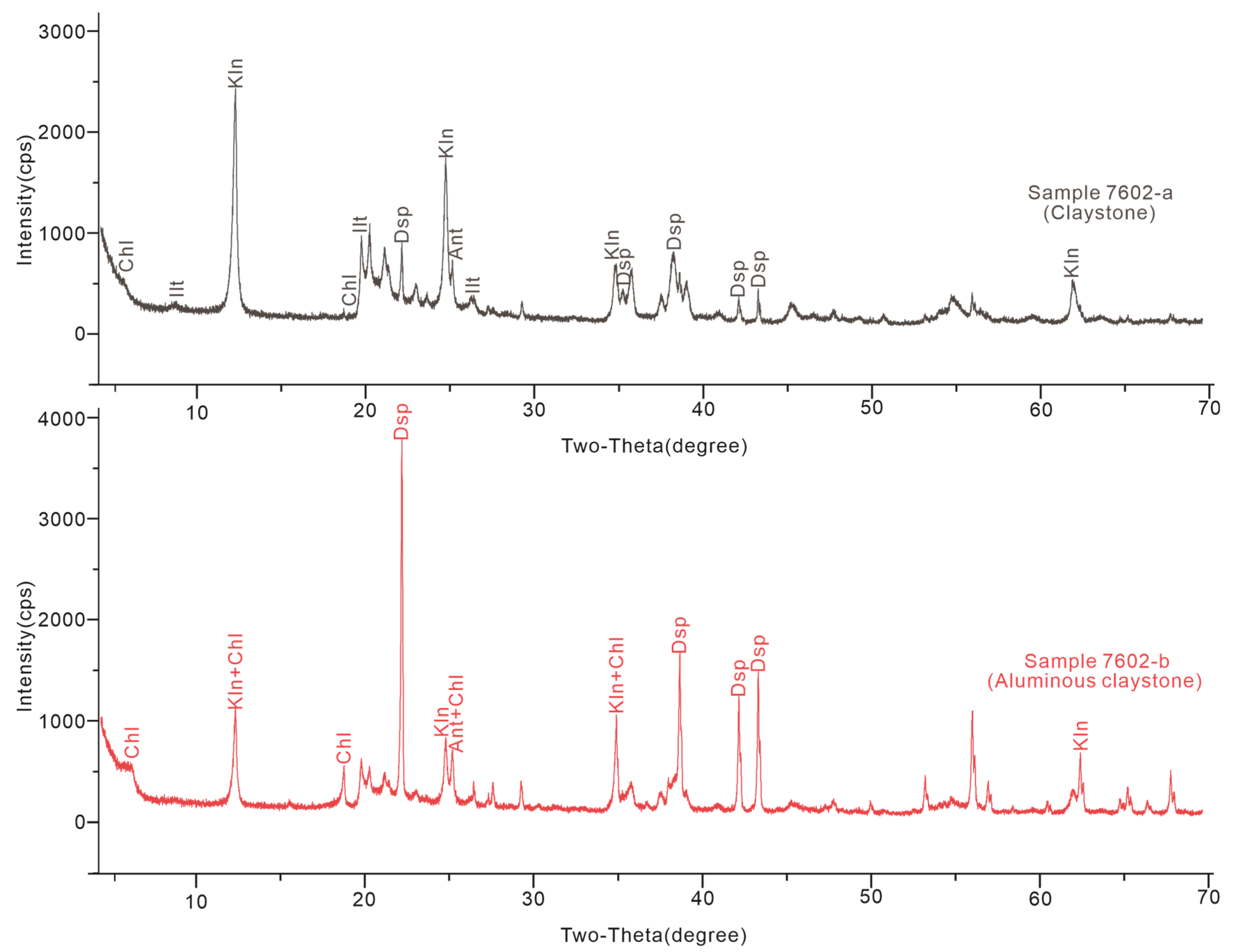
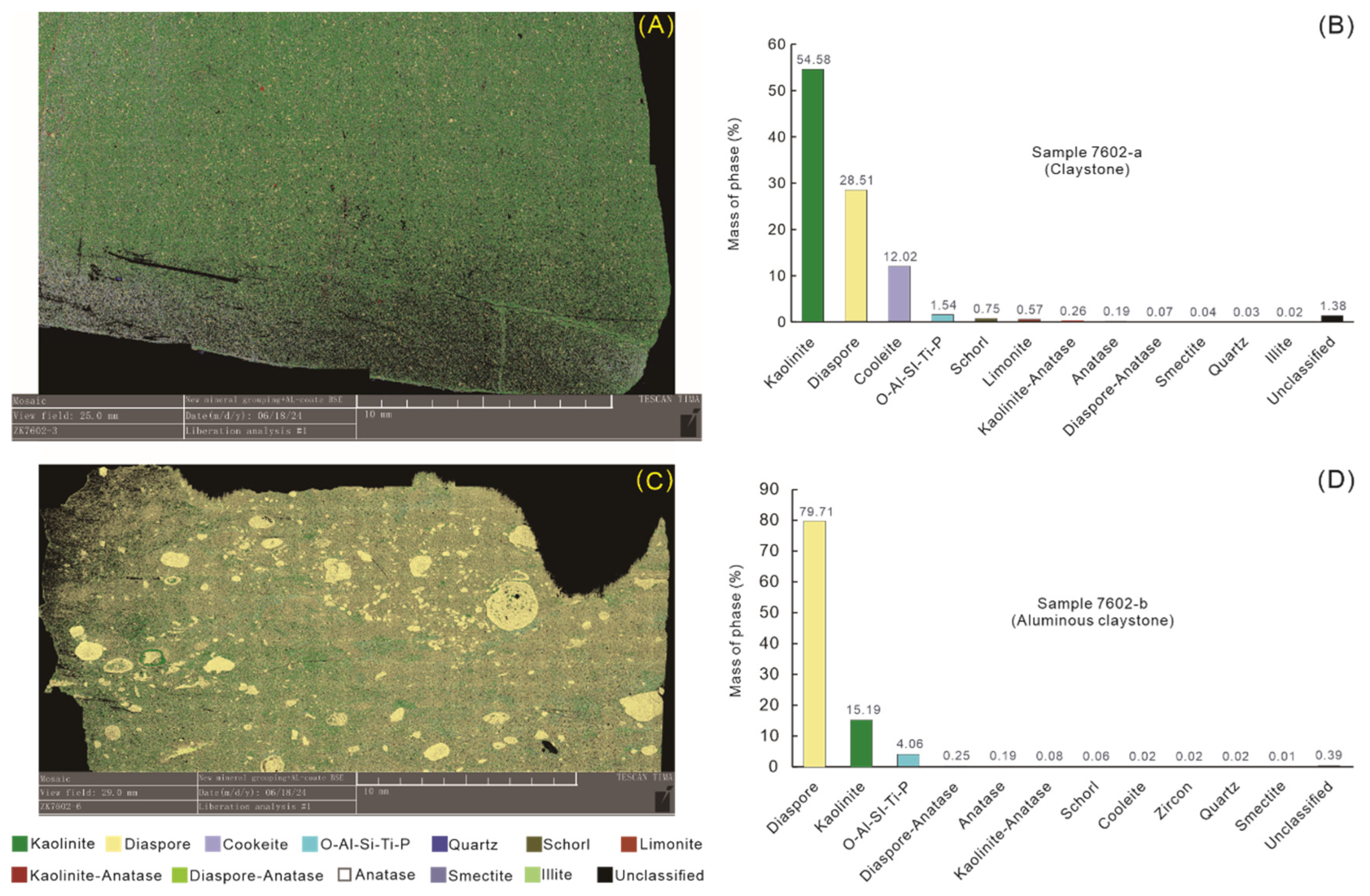
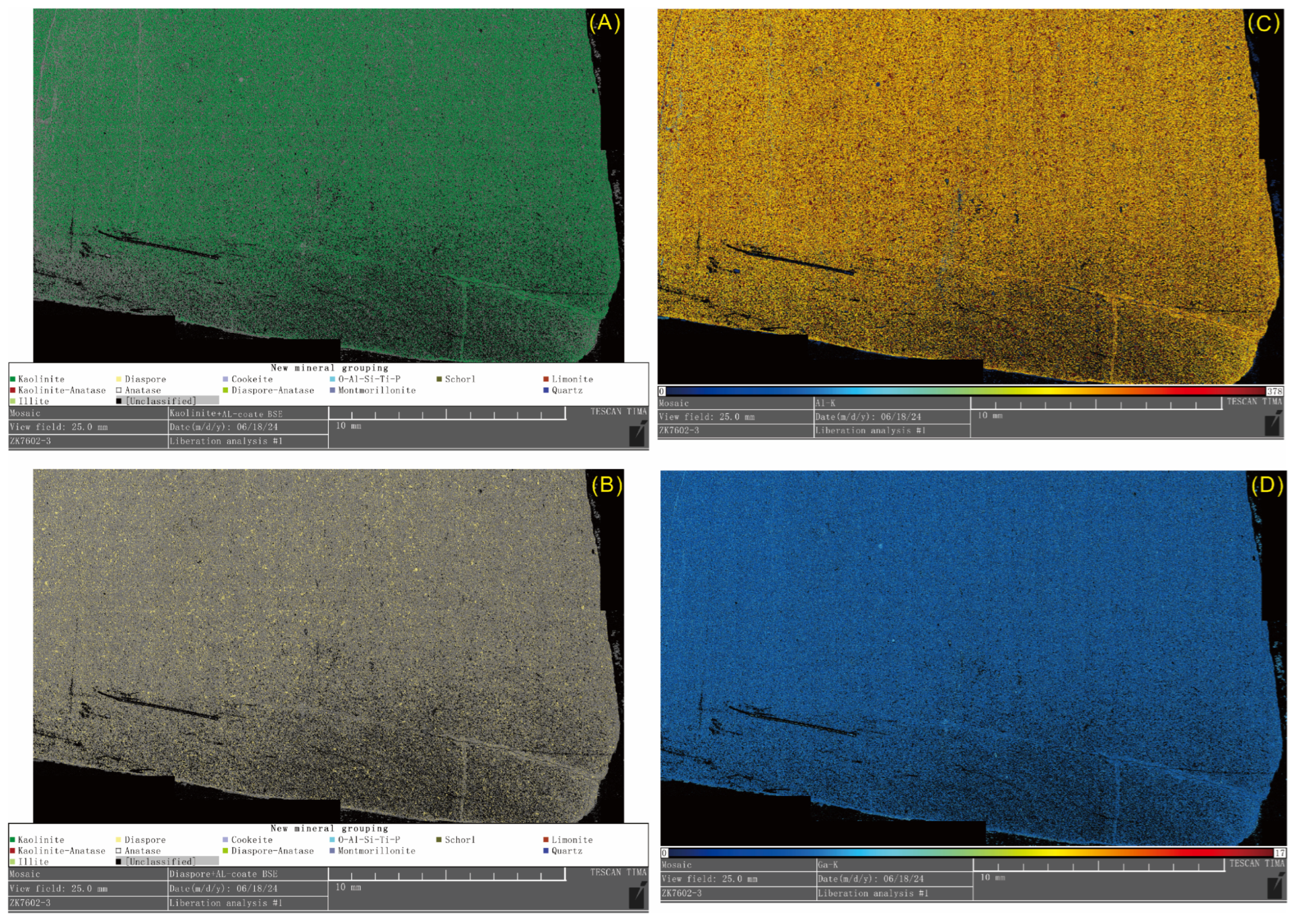
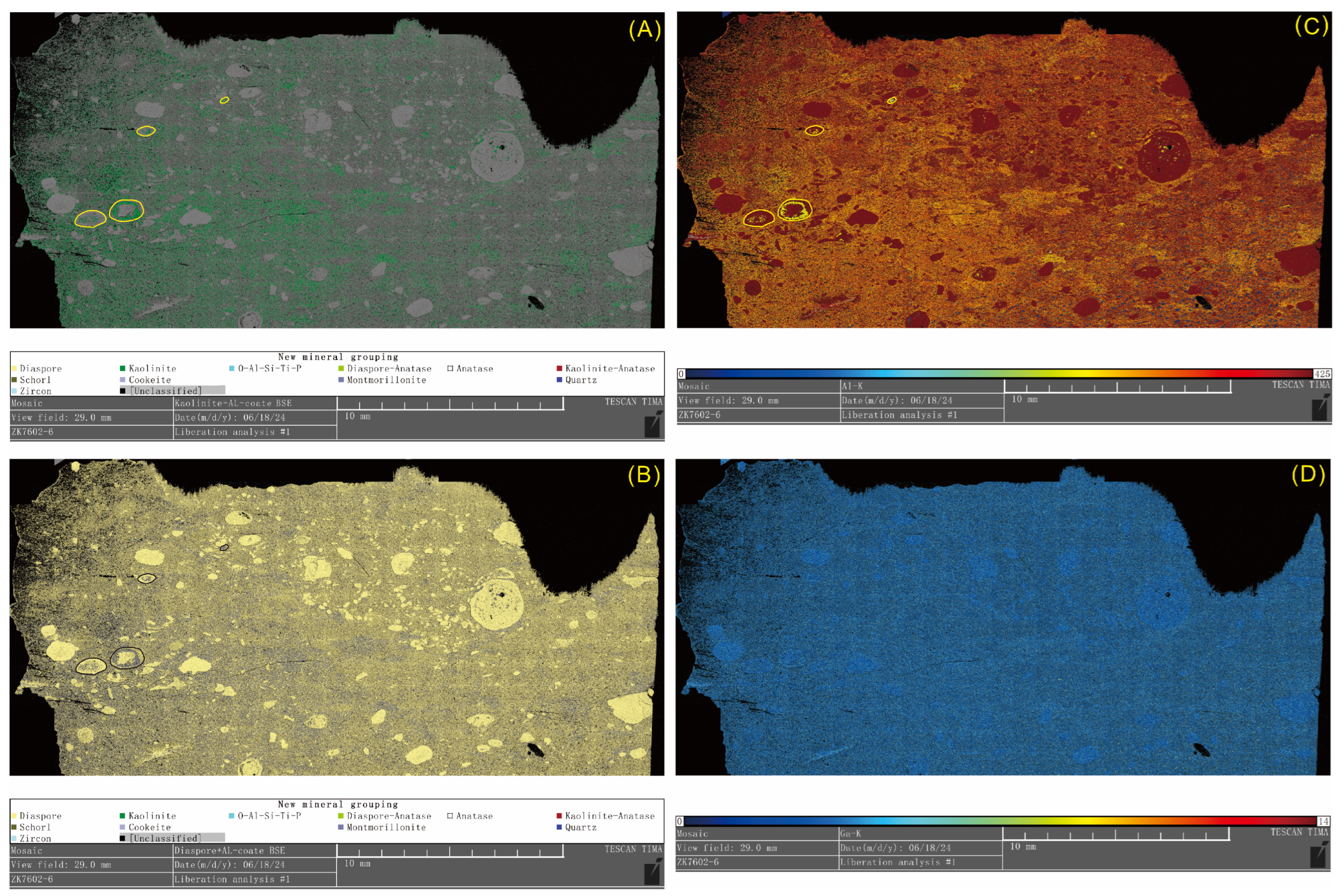
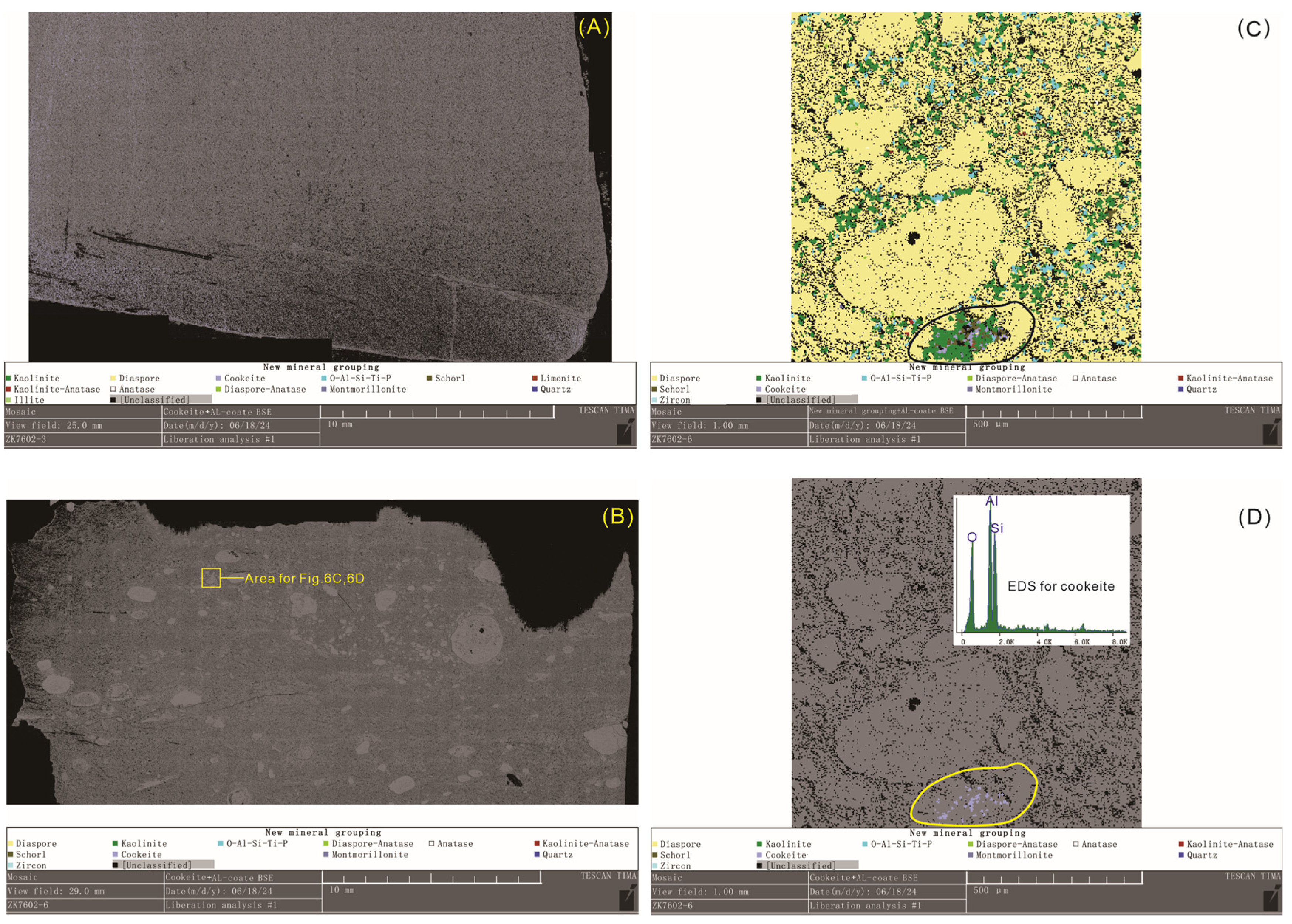
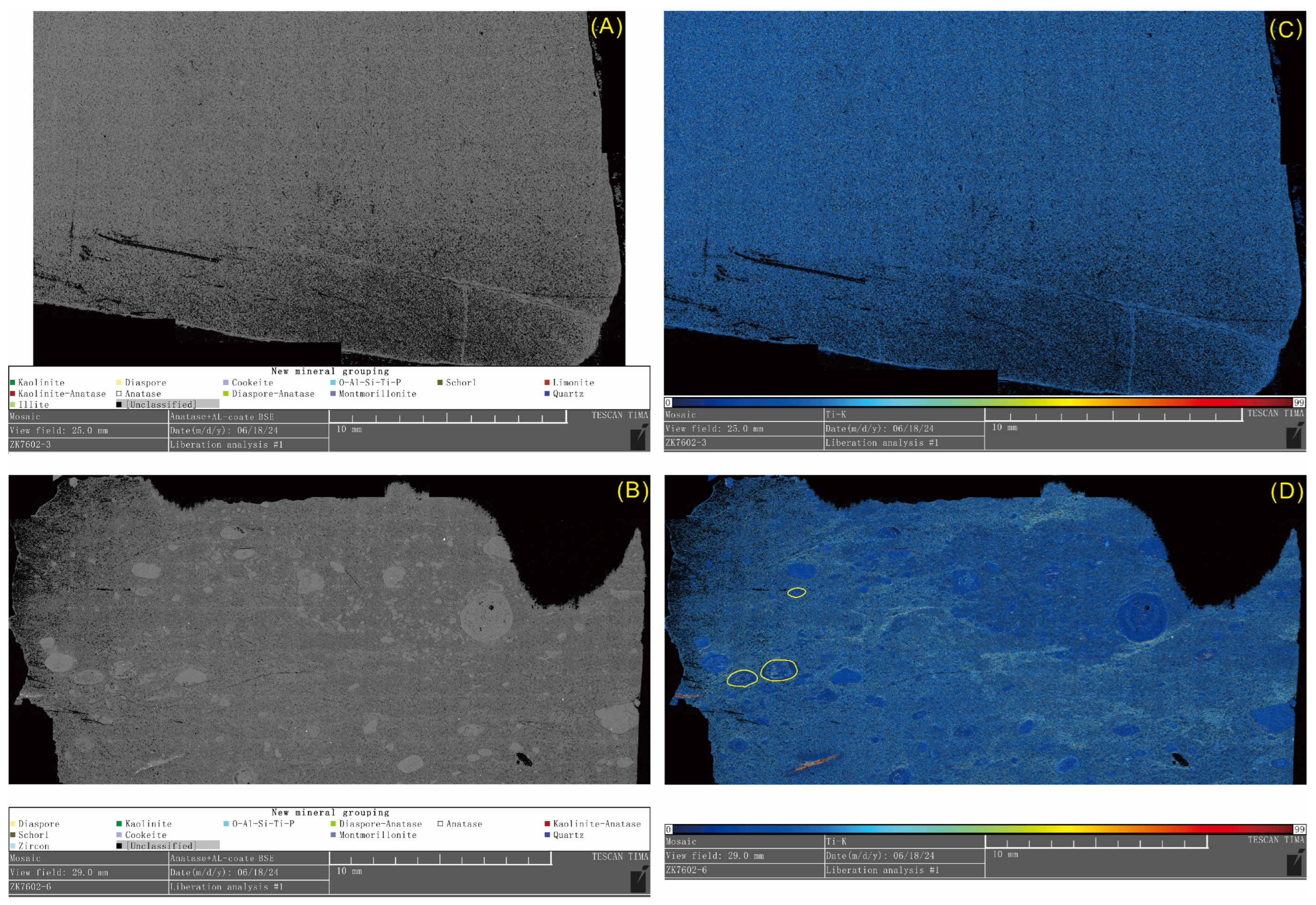
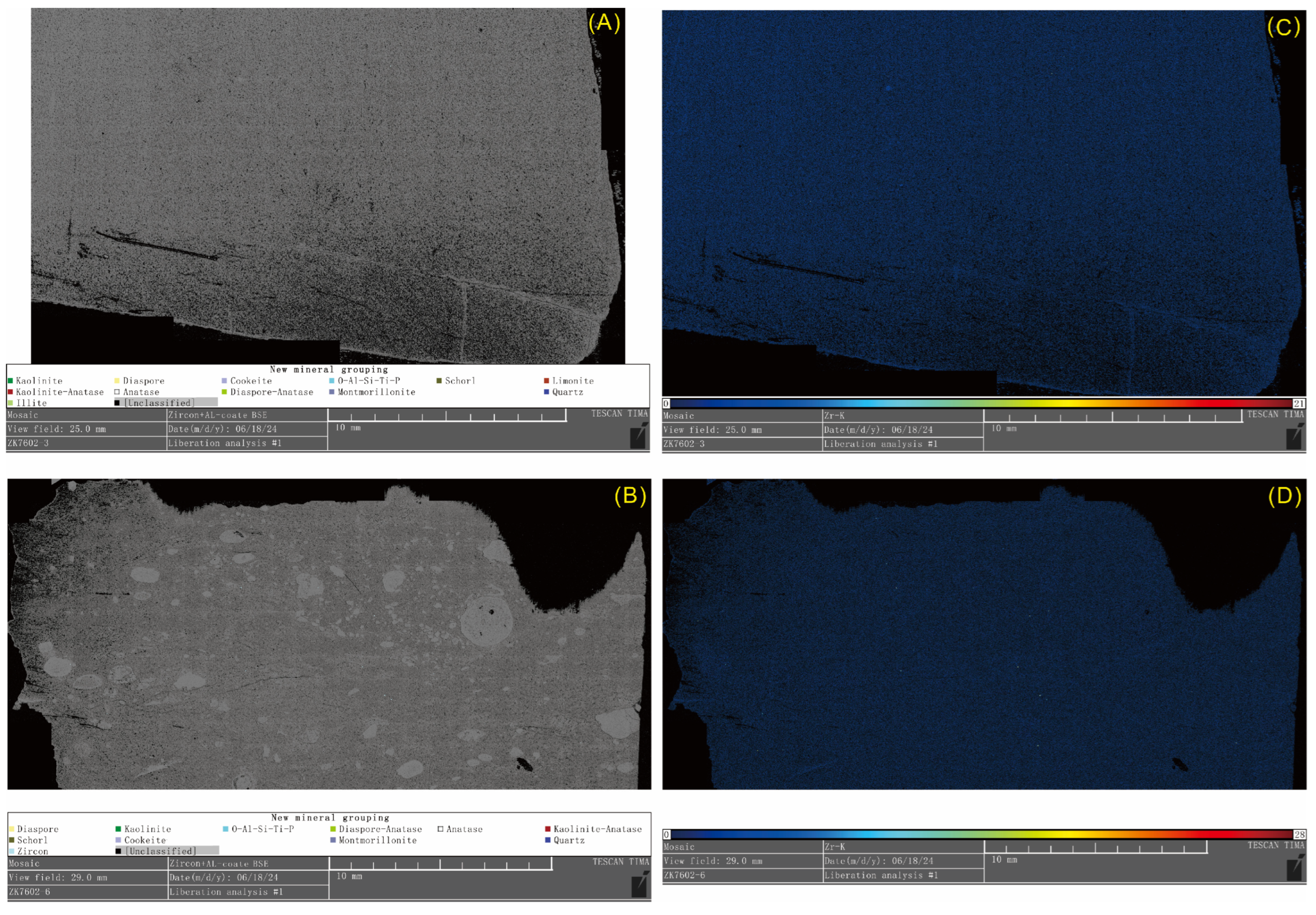
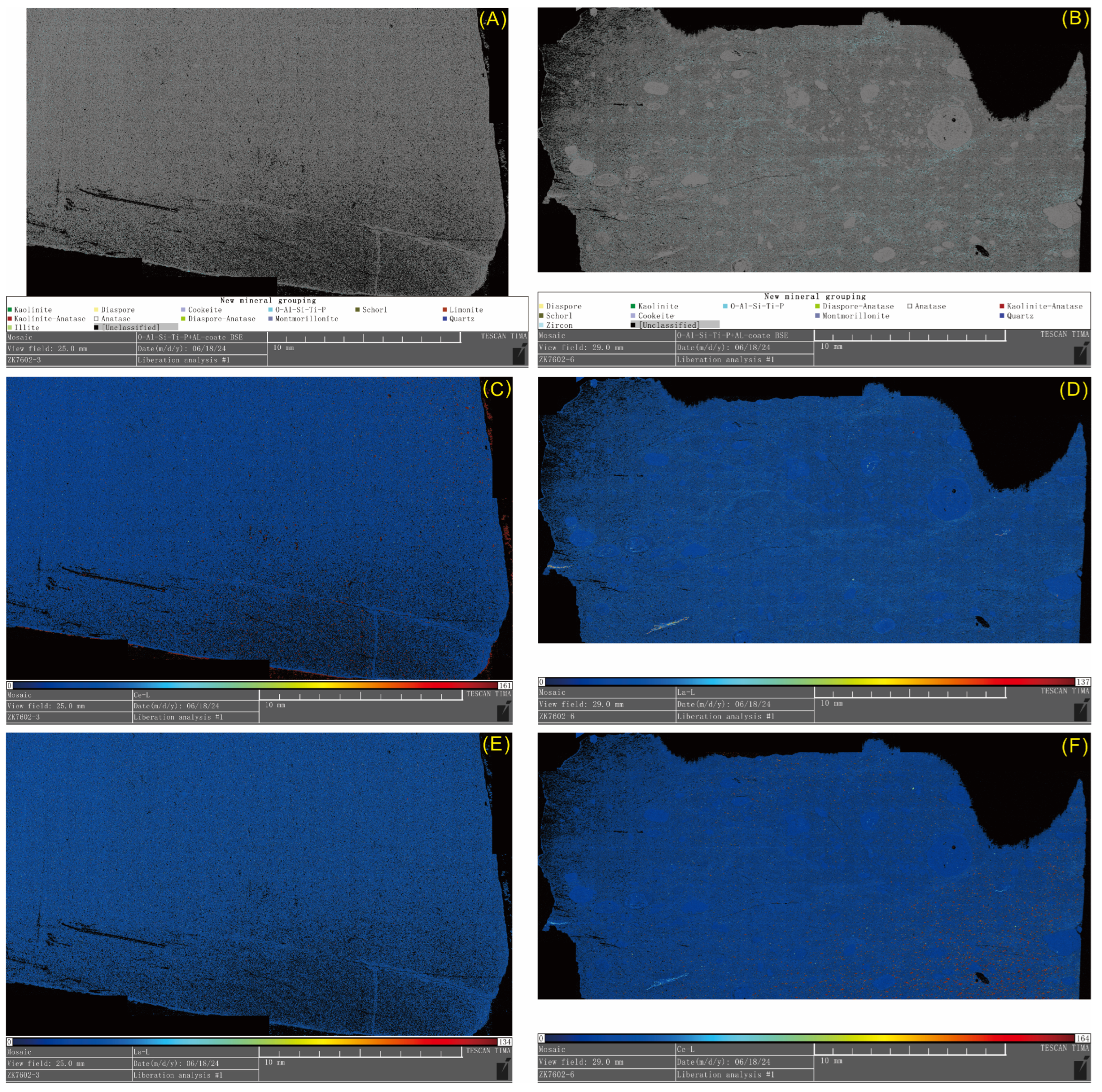
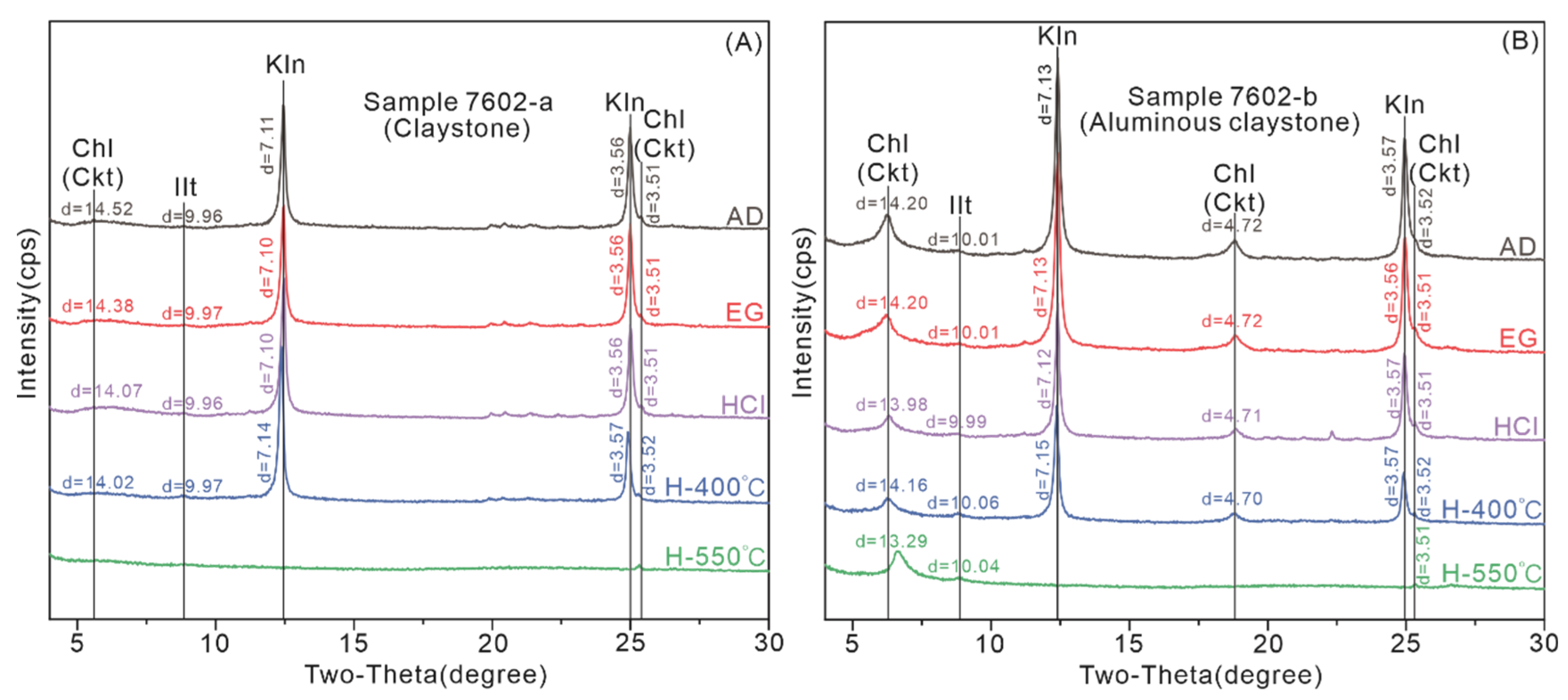
Disclaimer/Publisher’s Note: The statements, opinions and data contained in all publications are solely those of the individual author(s) and contributor(s) and not of MDPI and/or the editor(s). MDPI and/or the editor(s) disclaim responsibility for any injury to people or property resulting from any ideas, methods, instructions or products referred to in the content. |
© 2025 by the authors. Licensee MDPI, Basel, Switzerland. This article is an open access article distributed under the terms and conditions of the Creative Commons Attribution (CC BY) license (https://creativecommons.org/licenses/by/4.0/).
Share and Cite
Wang, N.; Xu, Y.; Zhao, J.; Zhang, S.; Liu, Z.; Hou, M. Mineralogy and Critical Metal Distribution in Upper Carboniferous Aluminum-Bearing Strata from the Yangquan Mining Area, Northeastern Qinshui Basin: Insights from TIMA. Minerals 2025, 15, 1069. https://doi.org/10.3390/min15101069
Wang N, Xu Y, Zhao J, Zhang S, Liu Z, Hou M. Mineralogy and Critical Metal Distribution in Upper Carboniferous Aluminum-Bearing Strata from the Yangquan Mining Area, Northeastern Qinshui Basin: Insights from TIMA. Minerals. 2025; 15(10):1069. https://doi.org/10.3390/min15101069
Chicago/Turabian StyleWang, Ning, Yingxia Xu, Jun Zhao, Shangqing Zhang, Zhiyi Liu, and Menghuai Hou. 2025. "Mineralogy and Critical Metal Distribution in Upper Carboniferous Aluminum-Bearing Strata from the Yangquan Mining Area, Northeastern Qinshui Basin: Insights from TIMA" Minerals 15, no. 10: 1069. https://doi.org/10.3390/min15101069
APA StyleWang, N., Xu, Y., Zhao, J., Zhang, S., Liu, Z., & Hou, M. (2025). Mineralogy and Critical Metal Distribution in Upper Carboniferous Aluminum-Bearing Strata from the Yangquan Mining Area, Northeastern Qinshui Basin: Insights from TIMA. Minerals, 15(10), 1069. https://doi.org/10.3390/min15101069






